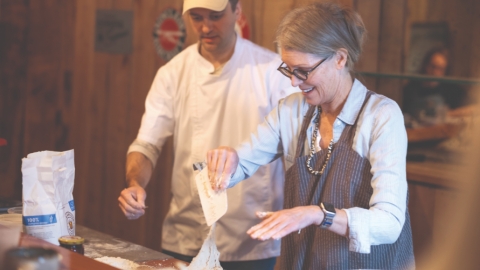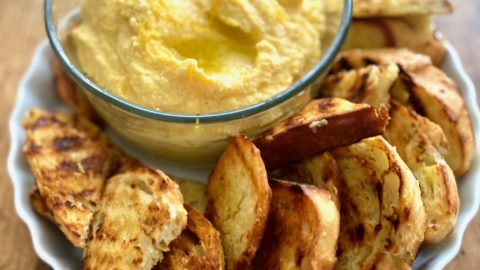Ingredients
- Large mixing bowl
- 4–6 quart Dutch oven
- proofing baskets or medium-sized mixing bowls with
- floured tea towels
- razor blade or sharp knife for scoring
- Levain build (starter to use in final dough)
- 170g bread flour (or all-purpose flour)
- 213g water (room temperature or 80–85F)
- 30g sourdough starter
- 680g bread flour (or all-purpose flour)
- 413g water (room temperature or 80–85F)
- 113g rye or whole wheat flour
- 18g salt (kosher or fine sea salt)
- 383g levain (ripe starter which has approximately doubled in volume)
About this recipe
1. Basic sourdough is only flour, water, salt and a pre-fermented portion of dough, levain, made with a yeast culture called starter.
2. The ratio of water to flour in bread recipes is called hydration and is super important. That's why it's best to use a digital scale to measure ingredients precisely. Hydration affects a bread's character, such as size of holes in interior crumb and crispness of crust.
3. "Sourdough" describes the fermentation process, which involves both yeast and bacteria, which give sourdough its characteristic tangy flavor.
4. Before yeast was isolated into the granules we know today, all bread was sourdough, relying on a starter or colony of microorganisms kept alive in a slurry of water and flour.
5. Some people are senseigive to phytic acid, and find sourdough easier to digest. This is because the lactic acid–producing bacteria produce an enzyme—phytase—which effectively pre-digests phytic acid during extended fermentation.
6. Home bakers can get bakery-quality results using a Dutch oven. Leaving the lid on to steam the bread for the first half of the bake enables more oven spring or rise. The steaming mimics steam-injected deck ovens at a bakery.
7. Scoring with a razor blade, before dough goes into the oven, creates designs you see on sourdough loaves. Residual flour from baskets the dough proofs in, provides contrast between the scoring and the surrounding crust. Other techniques, such as tying with string, can create pumpkin-like shapes as dough expands in the oven.
8. Sourdough is not conducive to braiding. It will all merges in the oven. Braiding is better for brioche and challah.
9. The most challenging part is shaping the dough before the final proof (rise). It takes a combination of rounding and tightening the dough into a ball. The movement requires finesse only possible through practice.
Instructions
1. Build the levain: Mix 30g starter culture with 170g flour and 213g water. Let sit at room temperature 4–8 hours until active and bubbly.
2. Mixing and autolyse: Mix 340g levain with 413g water. Add flours and mix into a shaggy mass. Rest for 20 minutes. (Remaining levain will be reserved and fed to use in future bakes.)
3. Kneading: Incorporate 18g salt and knead until smooth and supple, either by stretching and folding dough still in bowl and rotating bowl 90 degrees after every fold. Or use the “slap-and-fold” method on your countertop. Knead until you can stretch a piece of dough and see light through it but no holes—the windowpane test. Ben estimates this could take 2–3 songs on the radio. After kneading, return dough to bowl and cover.
4. Bulk fermentation—can be done same-day or overnight
- Same-day: Bulk ferment at room temperature 2–4 hours. During that time, give dough four folds in the bowl, then wait 40 minutes and repeat folding, then cover and let sit. When fermentation is done, dough should be wobbly and a few bubbles may surface. Ready for dividing.
- Overnight: Bulk ferment for 90 minutes at room temperature. Give dough four folds in the bowl, then wait 40 minutes and repeat folding, then re-cover and let sit. After 90 minutes, refrigerate overnight before dividing.
5. Divide, shape, proof—choice of same-day or overnight: Divide dough into two parts, shape into rounds and proof in proofing baskets or bowls with floured tea towels.
- Same-day: Proof 1–2 hours at room temperature. Do the poke test to see if proofing is complete by poking a floured finger into dough. If dent stays in and slowly bounces back, it is ready. If dent bounces back quickly, proof longer.
- Overnight: Proof in fridge overnight or up to 24 hours. It will be fully proofed the next morning straight from the fridge.
6. Score and bake: Preheat oven to 460F and set rack in middle. Put a 4- to 6-quart Dutch oven on the rack to preheat. Dump dough upside down from proofing basket onto a small sheet of parchment paper. Score dough with a razor blade at least once across the top. Place gently in Dutch oven. Bake 25 minutes with lid on. Remove lid and check to see if bottom is cooking too fast. If it is, move up oven rack and/or slide a cookie sheet on a rack below Dutch oven. Bake 15–25 minutes with lid off. Cool at least 10 minutes before slicing.












